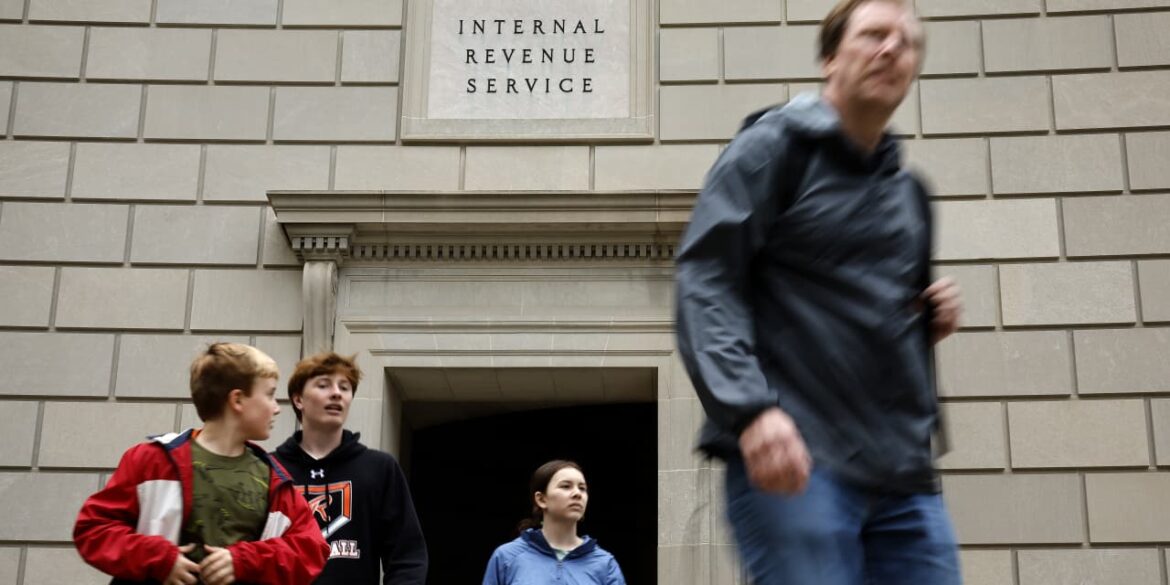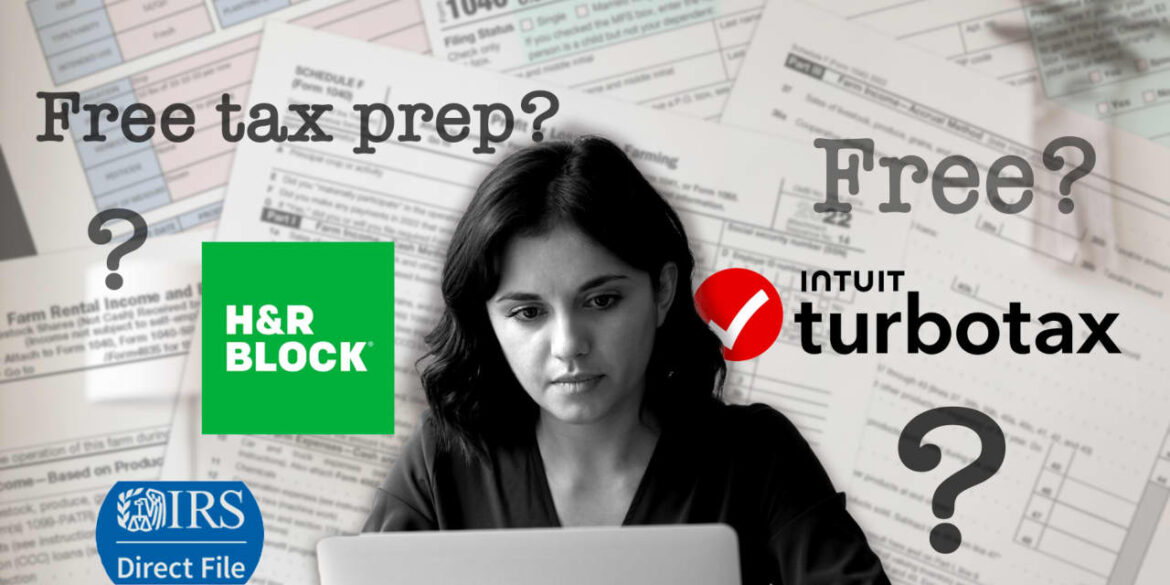
‘When I married my husband, he sold his house, which was valued at about $100,000 more than mine, but he had no equity in it.’
Source link
free
After weeks of testing with roughly 1,500 returns, Direct File, a free tax filing program from the IRS, is now fully open in 12 pilot states, according to the U.S. Department of the Treasury.
While the pilot focuses on “simple tax situations,” the Treasury estimates the pilot could cover about one-third of tax situations for 19 million taxpayers. The Spanish language version opens later on Tuesday at 1 p.m. ET.
“Dozens of countries have provided free tax options to their citizens for years,” Deputy Secretary of the Treasury Wally Adeyemo said during a press call on Monday. “American taxpayers who want to file their taxes for free directly with the IRS should have that option.”
More from Personal Finance:
Trump vs. Biden: What a presidential election rematch could mean for your taxes
Tax pros brace for ‘tidal wave’ of crypto tax scrutiny from the IRS. What investors need to know
IRS targets wealthy ‘non-filers’ with new wave of compliance letters
Treasury officials hope at least 100,000 taxpayers will participate in the Direct File pilot for 2023 filings as the agency makes future decisions about the program, Adeyemo said.
Within five years, the program could save the average filer $160 per year, or a collective $11 billion annually including tax prep fees and time, according to a report from the Economic Security Project released Monday.
IRS Direct File pilot states
The IRS Direct File pilot states include Arizona, California, Florida, Massachusetts, Nevada, New Hampshire, New York, South Dakota, Tennessee, Texas, Washington and Wyoming. Alaska was originally included but is no longer part of the pilot.
The soft launch and limited rollout were intentionally designed to capture data to make improvements and decisions for the future, a senior administrative official said.
Direct File pilot doesn’t support state returns, but the software will guide users from Arizona, California, Massachusetts and New York to a state-supported tax-prep tool.
Direct File pilot open to limited filers
You may qualify for Direct File with a simple, straightforward return, with limited types of income, credits and deductions, according to IRS officials.
The pilot will only accept Form W-2 wages, Social Security retirement income, unemployment earnings and interest of $1,500 or less. This excludes filers with contract income reported via Form 1099-NEC, gig economy workers or self-employed filers.
To qualify, you must claim the standard deduction, which is $13,850 for single filers and $27,700 for married couples filing jointly for 2023.
Direct File only accepts a few credits: the earned income tax credit, child tax credit and credit for other dependents. The software also accepts deductions for student loan interest and educator expenses.
Scrutiny of IRS Direct File
The Direct File pilot launch comes amid pushback from the private tax filing industry. There has also been scrutiny from some Republicans who have questioned the agency’s authority to create the program.
When asked about Direct File during a House Ways and Means hearing in February, IRS Commissioner Danny Werfel said the agency has “a responsibility and an authority to offer taxpayers different approaches for how to meet their tax obligation.”
Taxpayers have several free filing options this season, including IRS Free File, Volunteer Income Tax Assistance, Tax Counseling for the Elderly and private company software.
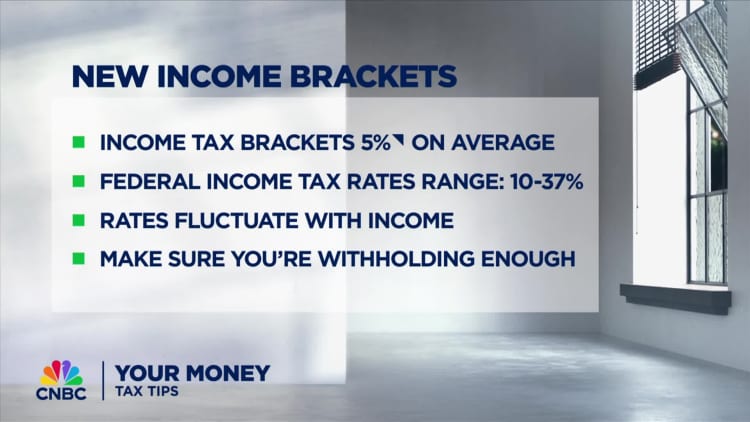
Want free tax prep from the IRS? Direct File will open soon in these 12 states.

The Internal Revenue Service’s free tax-prep platform will soon be open for business.
After slowly increasing capacity on its Direct File platform, the IRS will make the platform available to a wider audience on Monday, the agency said.
The platform is expected to be fully up and running on March 12. The pilot program can only prepare relatively basic tax returns, and it will only be available to eligible taxpayers in 12 states: Arizona, California, Florida, Massachusetts, Nevada, New Hampshire, New York, South Dakota, Tennessee, Texas, Washington state and Wyoming.
But Direct File marks the widespread debut of a free, government-run answer to mass-market online tax preparation from commercial providers like TurboTax
INTU,
and H&R Block
HRB,
Regulators at the Federal Trade Commission have alleged that both TurboTax and H&R Block misled consumers about the extent of their free tax-preparation services. Both companies deny the allegations.
There are other free tax-filing options out there, including the IRS Free File program. That’s an IRS partnership with tax-software companies available to taxpayers with incomes of up to $79,000.
The IRS Direct File program has no income limits, just like the free tax-prep programs from H&R Block
HRB,
and TurboTax
INTU,
But all three can only be used for certain types of tax returns, mostly simple ones.
The IRS has slowly rolled out Direct File, making it available to taxpayers for certain hours of the day. Starting March 4, it will be available to new users 24 hours a day every day, according to an IRS official.
However, people who want to use the platform should look for a notice at the top of the site saying it’s open. The platform may be temporarily unavailable at times if too many users take up all the available slots for a given day, the official said.
“But more spaces will be added every day, and our goal is to ensure that all taxpayers who are interested and eligible can try out Direct File for themselves,” the IRS official added.
Someone who has already started a tax return can keep working on it even if the site isn’t accepting new users, according to the IRS.
Users in Arizona, California, Massachusetts and New York — the four states on the list with a state income tax — can also be connected to free online preparation of their state returns. Direct File can also help users in Washington state who are eligible for a certain tax credit.
The Direct File program can handle returns with W-2 job wages, common credits like the child tax credit and the student-loan interest deduction. It can’t support returns that need to report capital gains or independent-contractor income.
People who plan to use Direct File should be ready to answer eligibility questions when they log on to the program. IRS officials who designed the platform said they wanted to ask up front to quickly sort out people who cannot use the service.
The IRS began accepting and processing 2023 tax returns on Jan. 29. It has now processed over 44 million returns through late February, agency statistics show. Taxpayers are receiving an average refund of $3,213, which is more than 4% higher than the average amount at the comparable point last year.
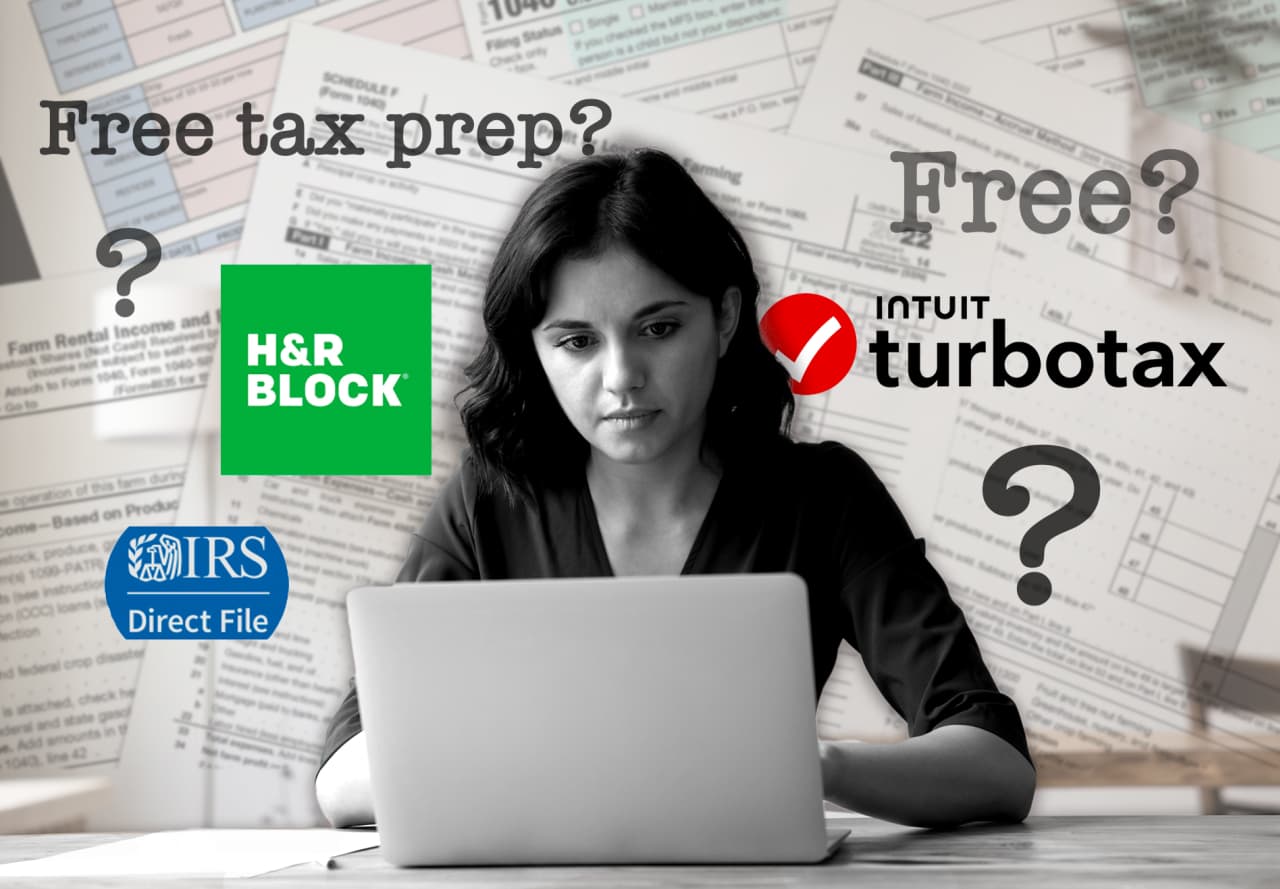
When major tax-preparation brands TurboTax, made by Intuit, and H&R Block say they’ll do income tax returns at no cost, that only applies to certain people.
Live a straightforward financial life with few complications or income sources? The two major players in mass-market tax prep say they will do your return for free. But if your tax return has just a few financial wrinkles, TurboTax and H&R Block will charge you money, according to the fine print.
For example, Intuit’s
INTU,
TurboTax and H&R Block
HRB,
say users have to pay for tax returns that will report sales of stock and cryptocurrency. The same is true if the taxpayer has income to report from gig work.
There can also be extra costs for certain tax-prep services. Want some AI-infused help from H&R Block? The price starts at $35 for a federal return and $37 per state return.
TurboTax says its own AI-powered tax help is available on all of its free products this tax filing season. And its “TurboTax Live Assisted Basic,” which lets taxpayers ask questions of tax pros in real time, is free through March 31, according to a spokeswoman. But only customers who have “limited credits” — meaning they have a simple tax return and they’re claiming the earned income tax credit or child tax credit, but no other tax credits — can take advantage of that offer.
Prices on tax software are a prickly topic this tax season. Last week, the Federal Trade Commission ruled that TurboTax used deceptive advertising for years when it promoted its free services without clearly explaining that many taxpayers weren’t eligible for its free option.
Intuit said it will appeal the FTC’s “deeply flawed decision” and insisted to regulators that its disclosures were sufficient. TurboTax now says around 37% of tax filers qualify for its free edition, and some of its current TV ads highlight this.
Meanwhile, Intuit sued H&R Block, alleging that H&R Block’s advertising misleads potential customers about TurboTax’s prices and how the rivals compare. H&R Block countered in court papers that Intuit is “aggressively seeking to avoid legitimate comparative price advertising.” Both companies declined to comment on the lawsuit.
Overall, it’s “incredibly challenging” for people to understand whether free tax-preparation offers really apply to them, said Nina Olson, the former IRS national taxpayer advocate.
The “up-sell problem” — where customers start a tax return thinking it’s going to be free, but then the tax-prep company ends up charging them — has been an issue for at least two decades, and it’s not limited to any one company, said Olson, who retired from the IRS to start the nonprofit Center for Taxpayer Rights.
Olson is fine with tax-prep companies only providing free tax prep for “plain vanilla” returns. Taxes are complicated, she noted. But “transparency is a wonderful thing, and that’s what we’ve got to get better at, so consumers are aware what they are signing up for,” Olson said.
Both TurboTax and H&R Block say they are upfront with consumers. Here’s a MarketWatch breakdown on who qualifies for the free editions of TurboTax and H&R Block, and tips on other ways to file your taxes for free, including IRS Direct File, IRS Free File and other free programs.
Who is eligible for TurboTax’s free edition?
The free version of TurboTax is available to people who use a Form 1040 (the most basic type of income-tax form) to file their taxes, and who only file “limited credits,” meaning the earned income tax credit and the child tax credit, but no others.
TurboTax says its free edition can handle wages paid by an employer and reported on a W2. It can also support income from interest and dividends reported on a 1099-INT or a 1099-DIV that is below $1,500. (Sums above that amount require a Schedule B and the free edition will not cover that.)
It can also handle the taxes connected to money coming from a retirement account, like a 401(K), or a pension, a spokeswoman said.
TurboTax’s free edition applies the standard deduction, which most taxpayers use instead of itemizing their deductions. It also applies the student-loan interest deduction.
But the free version will not support income from unemployment benefits, capital gains taxes, business income or self-employment taxes. It’s also not built for the taxes on money paid to an independent contractor, which generally comes on a 1099-NEC.
The free edition has no income maximum and it covers both federal and state returns, according to an Intuit spokeswoman. Credit Karma, which is also owned by Intuit, has a free offer for people who did not use TurboTax last year and it can handle more tax complexity, the spokeswoman noted.
More than 10 million people file their taxes for free with TurboTax each year, Intuit said in court papers and elsewhere.
Who is eligible for H&R Block’s free edition?
Similar to TurboTax, H&R Block’s free version is mostly limited to taxpayers with relatively simple returns filed on a 1040 — but it does have some more capabilities than TurboTax’s free product.
A federal and state return filed with H&R Block Online can be done for free, according to the company. The free return supports income from W2 wages, Social Security income, unemployment benefits and interest and dividends under $1,500. Normal retirement distributions pulled from accounts like a 401(k) may fit the free version, depending on a taxpayer’s circumstances.
It handles the child tax credit and the earned income tax credit. It also applies the standard deduction, student-loan interest deduction and education credits. It can also handle the American Opportunity Credit and Lifetime Learning Credit, which are linked to an eligible person’s educational pursuits.
There’s also no income limit on the H&R Block free offering, so long as the taxpayer sticks with the applicable credits and deductions.
How can I file my taxes for free with IRS Direct File?
The IRS Direct File platform, the government-run version of free tax-prep software, is intentionally starting small, IRS officials said. It will be available to residents in 12 states starting around mid-March. Similar to the TurboTax and H&R Block free versions, only certain taxpayers are eligible to use Direct File.
It can handle income reported on W-2 job wages, unemployment benefits and Social Security payments. It can also handle interest income up to $1,500. It applies the child tax credit, the earned income tax credit and deductions for student-loan interest and $300 out-of-pocket expenses for teachers.
But Direct File cannot process the tax credit for households with health insurance through the Affordable Care Act’s exchange. It also can’t handle provisions like the “saver’s credit” for retirement contributions, independent contractor money or capital gains.
The 12 states where Direct File will be available are: Arizona, California, Florida, Nevada, New Hampshire, New York, Massachusetts, South Dakota, Tennessee, Texas, Washington state and Wyoming.
Another option for free tax prep: IRS Free File
While taxpayers will have to wait for the IRS Direct File platform, there’s another free option that’s ready to use now: the IRS Free File program.
To qualify for IRS Free File this year, households can make up to $79,000, which is roughly 70% of households.
The Free File program is an IRS partnership with some tax software companies — but not TurboTax and H&R Block. The program has run for two decades yet few taxpayers take advantage of it. “It’s a good product. We just need more people to know about it,” said Tim Hugo, executive director of the Free File Alliance.
This year, the program has eight tax software providers and some offer free state returns in addition to free federal returns. One caveat: Some of the providers cap the income limits for their Free File offerings at levels under $79,000.
The eight providers are: 1040Now; 1040.com; ezTaxReturn.com; FileYourTaxes.com; On-Line Taxes; TaxAct; FreeTaxUSA; and TaxSlayer.
“Free File can provide a multitude of services,” Hugo said. “You can have very complicated returns,” he added. Free File providers offer the same customer service for their free customers and their paying customers, Hugo said.
The IRS has a list of the tax scenarios that Free File providers can handle. It includes capital gains and losses, self-employment taxes, and child and dependent care expenses — all of which aren’t included in the free versions of TurboTax and H&R Block, or IRS Direct File.
Through May 2023, the IRS took in 2.7 million Free File returns, a 10% decrease year over year, according to a Treasury Department watchdog.
Other ways to get free tax-prep help
There are other IRS-backed free tax-preparation programs. They include the Volunteer Income Tax Assistance program and the Tax Counseling for the Elderly program.
Income thresholds are generally around $64,000 for VITA. The TCE program is geared at taxpayers age 60 and above. Here’s a link where to find nearby organizations participating in the VITA and TCE programs.
The people doing these tax returns are IRS-certified volunteers. The hours and services might be limited, the IRS says. But these volunteers can do basic tax returns, along with IRA distributions, pension income, simple forms of capital gains, self-employment income and some itemized deductions.

I enjoy walking for miles and miles if it is flat, but when I recently had to climb up a set of steep steps to a T station in the Boston suburbs, I was winded. Not to mention embarrassed when my companion was breathing just fine.
Chagrined, I hit the stair climber at the gym later, and within five minutes, my jagged breathing had my heart rate in the red zone. Afterward, I spoke to a nearby longtime gym stair climber, and she nodded as she kept pace with the rotating stairs.
“You have to start off slow,” she advised. “Then build up over a few weeks or so.” I need to work on this, and new research agrees.
Cardiovascular benefits
A recent Tulane University study with data from more than 450,000 adult participants found that climbing more than five flights of stairs (approximately 50 steps) per day can reduce the risk of atherosclerotic cardiovascular disease by 20%.
Atherosclerotic cardiovascular disease, or the thickening or hardening of the arteries caused by a buildup of plaque in the inner lining of an artery, includes coronary artery disease, ischemic stroke or acute complications. The study had a median follow-up time of 12.5 years.
“These findings highlight the potential advantages of stair climbing as a primary preventive measure for atherosclerotic cardiovascular disease in the general population,” noted study author Lu Qi, MD, Ph.D., chair and professor at the Tulane University School of Public Health and Tropical Medicine.
“Short bursts of high-intensity stair climbing are a time-efficient way to improve cardiorespiratory fitness and lipid profile, especially among those unable to achieve the current physical activity recommendations,” Qi said.
The researchers determined participants’ susceptibility to cardiovascular disease using family history, genetics and other risk factors like high blood pressure and smoking history. Lifestyle habits and frequency of stair climbing were also considered.
While the study concluded that climbing more stairs daily significantly reduced the risk of cardiovascular disease in those less susceptible, Qi noted that the increased risk of heart disease in more susceptible people could be “effectively offset” by daily stair climbing.
The availability of stairs makes this an affordable exercise people can fit into daily routines.
Plus: Look for these 6 nutrients in your diet to help ward off dementia and keep your brain sharp
Additional benefits
Daily stair climbing is also associated with a decreased risk for metabolic syndrome, as reported by a 2021 study of late middle-aged men and women.
Data from 782 participants with an average age of 58 years were used to examine the association between self-reported daily stair climbing and metabolic syndrome (a cluster of conditions that occur together and increase the risk of heart disease, stroke and Type 2 diabetes).
According to Duke University, stair climbing can also help reduce the risk of injury from falls in older people, aid in maintaining a healthy body weight, and contribute to building and strengthening healthy bones, muscles and joints.
Blue Zone studies
Research from the Blue Zones demonstrated that people who walk steeply in their daily lives because of their geographic location have improved longevity.
Netflix’s
NFLX,
documentary “Live To 100: The Secrets Of The Blue Zones” highlighted the experiences of residents from the hilly regions of Sardinia, Ikaria and Costa Rica who have been found to live longer than average.
The series referred to findings of a study by Gianni Pes and colleagues that showed the positive health effects of going up and down the stairs or steep slopes or hills in daily life correlated to longevity in Sardinia.
The researchers noted that these populations maintained a traditional lifestyle with intense physical activity beyond the age of 80, had a reduced stress level, strong family/community support and mainly ate locally produced food.
Read: At 65, I thought I could eat whatever I wanted—until I woke up in an ICU
Add more stairs to your day
The advice to take the stairs instead of the elevator or escalator is an accessible way to incorporate steep walking or stair climbing into daily activity to improve health (be sure to check with your physician before increasing activity or starting a new exercise routine).
Great options to incorporate the stairs may include the subway, train or bus lines. These easy-access stair areas tend to incorporate brief bursts of steep stairs to help you easily get your steps in.
“If you’re already using the steps on your commute, it’s time to increase your speed, or take two steps at a time to increase the intensity,” said Alicia Jones, a certified fitness instructor specializing in fitness for women over 50.
Personal fitness trainer and over-50 fitness expert Stephen Holt noted people can start with the steps in their homes. “I would advise older people to address stair climbing like another other form of resistance training (with the “resistance” in this case being body weight),” Holt said.
“Depending upon one’s current condition, of course, break up stair climbing into three to four sets spread throughout the day at least twice a week on nonconsecutive days,” he explained.
“The simplest way to start is with one step (with or without the support of the banister). Start at the bottom, then place one foot on the next step. Then, bring the second foot up to the step so that both feet are now on the step.”
“The trick to making this a strengthening exercise is to step up by driving the first foot into the step, as opposed to pushing off with the bottom foot. Repeat by bringing the second foot down each time. The top foot stays stationary on the step until all reps are completed,” he said.
Alternate top foot and complete six to eight reps a few times weekly. Working out at the gym can provide the benefits of climbing as well. Michael Sawyer, operations director at Ultimate Kilimanjaro, an expedition company on Mount Kilimanjaro, has experience with intense climbs.
“When you put your body through activities like climbing and steep walking, you are conditioning your body to move blood and oxygen through itself more efficiently because climbing is rather laborious.”
“When your body is performing labor-intensive exercise on a regular basis, your cardiovascular system becomes used to productively moving blood around your body and oxygen to your lungs,” he said.
However, you don’t have to go on a mountain expedition to get your climb in. “A stair step machine, an elliptical, and even a staircase works just as well. For reps, I always recommend starting with about five to 10 minutes, then building up to 20 to 30-minute daily climbs,” Sawyer said.
Check out: When a cardiologist invited his patients to walk with him in a local park, 100 people showed up. It was the beginning of a global program.
Up the incline
A treadmill is another way for older adults who are new to climbing or steep walking to begin, according to Jones.
“When on the treadmill, you can adjust the incline to your starting level. I suggest 3.5 to start. From there, as you get more conditioned, you can increase the incline,” she explained, adding that the treadmill helps in forward walking motion due to the treadmill belt.
Although steep climbing or stepping usually is quite an advanced activity, the ability to adjust the incline and the speed of your walk makes it a much easier starting point, she noted. “The treadmill is also easier on your knees (if you have arthritis or knee pain). Our walking gait is different on a treadmill (we take smaller steps), which makes it easier on our joints,” Jones added.
Also see: Can you run after age 50? These coaches and runners and a physical therapist say you can and should. Here’s how to do it safely.
Hit some hills
A daily walk or hike that has some hills also can improve your endurance. “Hiking and walking are often some of the most preferred physical activities. Being out in nature and breathing the fresh air makes this vigorous activity feel easy,” said Jones.
She recommended finding a hilly yet scenic terrain to hike up, such as smaller hills with peaks and dips to allow for rest in between. Assembling a few friends or joining a walking group can make the activity fun and create more social connections.
Read next: Walking can help you lose weight and get fit — if you do it right. Here’s how to reap rewards from your rambles.
No matter which activity you choose, commit to consistently increasing your steps over time. After a recent brunch meetup with a friend, we walked around the neighborhood. Chatting away, I noticed my breathing catching as we made our way up an incline.
Clearly, I still have some more work to do.
Lisa B. Samalonis is a writer and editor based in New Jersey. She writes about health, parenting, books and personal finance.
This article is reprinted by permission from NextAvenue.org, ©2023 Twin Cities Public Television, Inc. All rights reserved.
More from Next Avenue:
Billionaire Warren Buffett Has A McDonald’s Gold Card That Gives Him Free Meals For Life — Jokes ‘So That’s Why The Buffett Family Has Christmas Dinner At McDonald’s’
Legendary investor Warren Buffett is known for his modest lifestyle and frugal habits, despite his immense wealth. In 2007, he revealed in an interview something unique he always keeps in his wallet: a McDonald’s gold card that entitles him to free meals in his hometown of Omaha, Nebraska, for the rest of his life.
The card exemplifies his simple living while adding an amusing twist to his persona. “So that’s why the Buffett family has Christmas dinner at McDonald’s,” Buffett said.
Buffett’s McDonald’s gold card is just one example of his unpretentious approach to wealth. His breakfast routine further illustrates this. According to the HBO documentary “Becoming Warren Buffett,” he spends no more than $3.17 on breakfast each day, usually opting for a drive-thru at a nearby McDonald’s.
Don’t Miss:
-
The average American couple has saved this much money for retirement — How do you compare?
-
The vodka market is set to soar at 5.6% CAGR to $40 billion by 2030. Join Lit Vodka’s journey for a piece of the premium spirits pie.
He chooses among three different breakfast options based on how prosperous he’s feeling. These options range from two sausage patties for $2.61 to a bacon, egg and cheese biscuit for $3.17. Breakfast is now slightly more expensive because of price increases since the documentary was filmed in 2017.
In another instance showcasing his thrifty nature, Buffett once used coupons to treat fellow billionaire Bill Gates to lunch at McDonald’s during a trip to Hong Kong. Recounting the experience, Gates said, “Remember the laugh we had when we traveled together to Hong Kong and decided to get lunch at McDonald’s? You offered to pay, dug into your pocket and pulled out … coupons.” This gesture was notable as Buffett’s McDonald’s card is only valid in Omaha, so he resorted to using coupons elsewhere.
At Allen & Co’s annual “summer camp for billionaires,” Buffett’s wife, Astrid, expressed dissatisfaction over the cost of a cup of coffee at the resort. Despite her husband’s net worth exceeding $115 billion, Astrid Buffett was reportedly frustrated with having to pay $4 for a cup of coffee, remarking that the same amount could buy a pound of coffee at more reasonably priced venues.
Trending: Funders on this alternative asset platform are earning more than 14% annualized consignment profit funding Pro consignment opportunities.
Buffett frowns on the extravagant habits of others, even among his wealthy peers. “I just naturally want to do things that make sense,” he said. “In my personal life, too, I don’t care what other rich people are doing. I don’t want a 405-foot boat just because someone else has a 400-foot boat.”
Saving and investing wisely, as Buffett has done throughout his career, are key to ensuring a comfortable and secure future. Buffett’s choices, from living in a house he bought in 1958 for $31,500 to his practical approach to everyday expenses, reflect a deeper understanding that contentment comes from financial prudence and the peace of mind it brings.
This mindset doesn’t diminish the importance of being financially prepared for the future. Instead, it encourages a balanced approach: enjoying life’s simple pleasures while also making smart financial decisions.
Investing wisely, saving for the future and spending within one’s means are not just paths to financial security but also to a fulfilling life that isn’t dictated by the pursuit of material wealth. Buffett’s life teaches that while money may not buy happiness, being smart with money can contribute to a happier, more stable life.
Read Next:
-
This brokerage offers custom rewards for users to switch – the biggest reward so far for 1 user is $19,977.48. Will yours beat it?
-
Get equity and front row seats to the startups and small businesses you love — for as little as $100.
“ACTIVE INVESTORS’ SECRET WEAPON” Supercharge Your Stock Market Game with the #1 “news & everything else” trading tool: Benzinga Pro – Click here to start Your 14-Day Trial Now!
This article Billionaire Warren Buffett Has A McDonald’s Gold Card That Gives Him Free Meals For Life — Jokes ‘So That’s Why The Buffett Family Has Christmas Dinner At McDonald’s’ originally appeared on Benzinga.com
© 2023 Benzinga.com. Benzinga does not provide investment advice. All rights reserved.
With the airdrop distribution now complete, Jito states that all claimable tokens will be available for 18 months starting on the token generation date.
Jito, a decentralized finance (DeFi) liquid staking protocol based on the Solana (SOL) ecosystem, started the distribution of its long-awaited airdrop on Thursday, sharing a total of over 90 million of its native token to early birds who helped in bootstrapping the network.
According to reports, the digital asset JTO, which also serves as the governance token within the protocol, was listed on many Solana-based exchanges at the floor price of $1.20 after the airdrop distribution.
However, as users began trading the asset, the token accelerated to almost $2. Decrypt reported that the total assets distributed are now worth $225 million.
Jito Airdrop Allocations
Qualified users received airdrops starting from 4,941 tokens, with the biggest being 104,391 tokens, depending on their interaction with the protocol using its so-called liquid staking token (LST), jitoSOL.
Earlier this week, the Jito Foundation, the non-profit company overseeing the network, released the airdrop eligibility and allocation plan.
The foundation allocated 80% of the airdrop to be shared among users who participated in the Jito Points program, which started in January and ended in November. Wallet addresses that held 100 Jito Points before November 25 were qualified to receive the airdrop.
In addition, 15 million of the assets were distributed to validators who operated the Jito-Solana client within the epochs 366 to 536 timeframe, specifically participating in at least one epoch between 527 and 536. Validators who were early adopters and actively contributed to the initiation of the Jito-Solana client will receive a higher token allocation.
The remaining tokens were designated for Jito MEV searchers utilizing the Jito Network’s suite of MEV programs. A total of 5 million JTO tokens have been granted to these searchers.
According to DefiLlama data, the platform ranks as the second-largest DeFi protocol on Solana, boasting a total value locked (TVL) of $456.14 million.
18-Month Claim Window
With the airdrop distribution now complete, the protocol states that all claimable tokens will be available for 18 months starting on the token generation date. However, any unclaimed assets will be moved to the DAO treasury.
Even with an extended claim window, 60% of the recently released tokens, amounting to 54 million out of 90 million, were claimed within the first four hours of the airdrop, according to data on Flipside Crypto.
Meanwhile, the protocol is not the first DeFi platform in Solana to airdrop its tokens to reward users for their contributions.
In September 2020, DeFi protocol Uniswap airdropped 150 million of its UNI governance tokens to users. The token is now worth over $900 million at current prices.
next
Altcoin News, Blockchain News, Cryptocurrency News, News
You have successfully joined our subscriber list.
AT&T Inc. topped free-cash-flow expectations during its latest quarter, and the company is raising its full-year outlook on the closely watched metric.
The telecommunications giant posted $5.2 billion in free cash flow for the third quarter in its Thursday morning report, exceeding the consensus view, which called for $4.8 billion. The company now expects about $16.5 billion in free cash flow for the full year, while it previously called for at least $16 billion.
Free cash flow is of key importance to AT&T
T,
investors given the company’s sizable dividend, and while management has expressed confidence in the 2023 target all year long, Wall Street had been showing a bit more caution, especially earlier in 2023 when AT&T fell short on the metric for the first quarter in a development it owed to misaligned timing expectations.
AT&T logged revenue of $30.4 billion for the latest quarter, up from $30.0 billion a year before. The FactSet consensus was for $30.2 billion.
The company posted net income attributable to common stock of $3.4 billion, or 48 cents a share, down from $6.0 billion, or 79 cents a share, in the year-earlier period. Results from the latest period reflected $600 million in severance charges and an 8-cent per-share negative impact from lower pension credits, among other factors.
Adjusted earnings per share came in at 64 cents, down from 68 cents a year before but above the 62 cents that analysts tracked by FactSet were projecting.
AT&T also recorded third-quarter adjusted earnings before interest, taxes, depreciation and amortization (Ebitda) of $11.2 billion, up from $10.7 billion a year before and above the $11.0 billion FactSet consensus. The company now expects at least 4% growth in adjusted Ebitda for the year, versus an earlier projection of at least 3%.
The company posted 550,000 total postpaid net additions for the quarter, and it pointed to 468,000 postpaid phone net additions. Phone average revenue per user inched up 0.6% to $55.99, reflecting “pricing actions, higher international roaming and a mix shift to higher-priced unlimited plans,” according to the earnings release.
AT&T added a net of 296,000 fiber subscribers to bring its total above 8 million.
Disney drops all but free speech claim in political retaliation suit against DeSantis
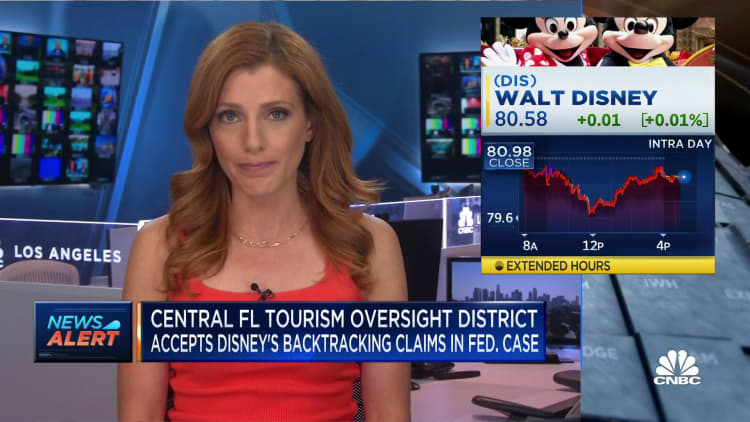
Disney on Thursday amended its federal lawsuit against Florida Gov. Ron DeSantis to focus solely on its First Amendment claim that the governor politically retaliated against the company.
Disney last week had asked to drop its other claims in the case, which concern a dispute over Walt Disney World’s development contracts, because they are being actively pursued in a separate state-level lawsuit in Florida.
“We will continue to fight vigorously to defend these contracts, because these agreements will determine whether or not Disney can invest billions of dollars and generate thousands of new jobs in Florida,” a Disney spokesperson said in a statement to CNBC.
Read more: Inside the epic CEO succesion mess at Disney
The revision, which nixes four claims Disney had previously presented in the case, shrinks the company’s federal civil complaint to 48 pages, down from 84 in the prior version.
Disney had already amended its lawsuit once in May to accuse DeSantis and his allies of doubling down on their attacks.
The second amended complaint filed Thursday afternoon is the latest legal wrinkle in Disney’s two lawsuits stemming from its protracted battle with DeSantis that began last year, when the company publicly denounced the controversial classroom bill dubbed “Don’t Say Gay” by critics.
DeSantis has leaned into culture-war battles as governor and on the campaign trail, as he seeks the 2024 Republican presidential nomination. He has tarred Disney with the politically loaded term “woke” and accused the company of “sexualizing children” — a claim Disney CEO Bob Iger called “preposterous and inaccurate.”
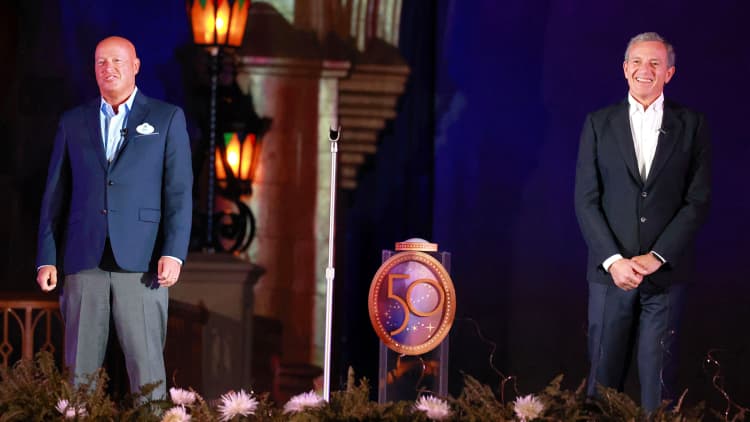
After Disney came out against the bill, which limits classroom discussion of sexual orientation and gender identity, DeSantis and his allies targeted the special tax district that had allowed Disney to effectively self-govern its Orlando-area theme parks for decades.
The governor signed measures changing the district’s name — from Reedy Creek Improvement District to Central Florida Tourism Oversight District — and replacing its five-member board of supervisors with his own picks.
Read more: Don’t bet on Apple buying Disney
Before the new board took charge, Disney crafted development contracts that it said were intended to secure its future investments in Florida. In April, the DeSantis board voted to nullify those contracts, prompting Disney to file its federal lawsuit.
The board countersued in state court in Orange County days later.
CNBC Politics
Read more of CNBC’s politics coverage:
Following Disney’s latest amendment to its federal complaint, the board said it was “pleased that Disney backtracked on these legal claims against the district in their federal case.”
“Disney’s latest legal move puts them in line with the position of what the district has been advocating for months now: that these matters should be decided in state court. We hope this helps expedite justice for the people of Florida,” said Alexei Woltornist, a spokesman for the district, in a statement to CNBC.
In the state-level case, Disney has filed counterclaims — including a breach of contract claim — and is seeking damages against the board. Earlier Thursday, the board asked that court to dismiss Disney’s counterclaims.
Text size

Johnson & Johnson Benadryl brand allergy medication is now a part of Kenvue.
Daniel Acker/Bloomberg
Johnson & Johnson
plans to maintain its quarterly dividend at $1.19 a share even after separating its
Kenvue
over-the-counter drug and personal care business.
It didn’t have to do that to keep its status as a Dividend Aristocrat. It did it because it can and because shareholders will like it.
On Wednesday, J&J (ticker: JNJ) updated its financial guidance following the completion of the exchange offer for
Kenvue
(KVUE) stock. J&J took about 191 million of its own shares for 1.5 billion shares of Kenvue stock it held. Kenvue raised money in an initial public offering in early May.
J&J is a Dividend Aristocrat, in the S&P 500 Dividend Aristocrats Index, which includes companies that have raised their payouts for at least 25 consecutive years. When an aristocrat separates a business,
S&P Global
(SPGI) looks at the payouts from the combined entities for a period of two years to make sure payouts are still rising.
Kenvue has already declared its first dividend of 20 cents a share. That means, theoretically, JNJ could have reduced its quarterly payout a little bit and maintained its Dividend Aristocrat status.
Investors didn’t have to participate in the exchange offer. So it was possible a non-participator could have seen a reduced dividend payout on their J&J holdings. They might not care about Aristocrat status if payouts fell by a nickel or so per quarter.
But it wasn’t a mistake for an investor not participate in the exchange, even if J&J adjusted the dividend. Someone who didn’t participate in the exchange now owns a slightly larger percentage of J&J. The company reduced its share count, taking in J&J stock and passing out Kenvue stock held. What is more, J&J still holds some Kenvue stock because not everyone participated in the exchange offer.
J&J holders, however, don’t have to worry about any of that. J&J is simply going to keep paying $1.19 a quarter for now. That will cost the company between $11 billion and $12 billion annually. No sweat. Wall Street projects J&J will generate roughly $26 billion in free cash flow in 2024, according to FactSet.
The dividend will consume less than half of the free cash flow. That isn’t a heavy burden. The average payout ratio for all dividend payers in the S&P 500 is about 50%.
Kenvue stock is up about 4% since its IPO in early May. J&J shares are down about 2% over the same span. The
S&P 500
and
Dow Jones Industrial Average
are up about 10% and 4%.
Dividend payers have been out of favor lately. The
ProShares S&P 500 Dividend Aristocrats ETF
(NOBL) is up about 5% year to date, trailing the S&P 500 by about 12 percentage points.
Write to Al Root at allen.root@dowjones.com



